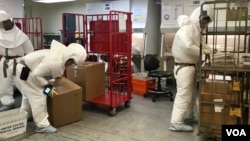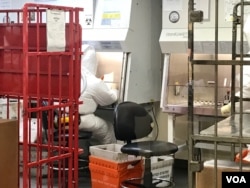Packages with explosive devices sent to news outlets and to prominent Democrats like former President Barack Obama and his former secretary of state, Hillary Clinton, highlight the challenges the U.S. Postal Service faces in responding to the threat of explosives and hazardous substances.
The Postal Service says it processes 493.4 million pieces of mail each day, or on average, about 20.6 million pieces each hour. Over the past two decades, it has had to take steps to prevent mail handling and deliveries from turning fatal.
The Postal Service, a federal entity, has seen its employees killed in handling correspondence containing biological material. Following the September 11, 2001 terrorist attacks on the U.S., two employees died at a mail processing facility in Washington after being exposed to anthrax-laced letters. That same year, letters containing anthrax arrived at media organizations in New York and Florida and at the offices of then-Senate Majority Leader Tom Daschle and Senator Patrick Leahy.
After the 2001 anthrax attacks, the government changed the way it handled such threats to keep mail centers, their staff and the public safe. The Postal Service launched a "Dangerous Mail Investigations" program to scrutinize suspicious packages nationwide. Equipment to test for airborne biological agents was installed in mail processing centers and the service began sterilizing mail addressed to federal buildings through an irradiation process.
For example, the mail distribution center at the Pentagon, the Defense Department’s headquarters less than six kilometers south of the White House, is located just outside the sprawling building.
The department's mail screening facility has about 15 employees who screen every envelope and parcel mailed to the Pentagon. All of those employees wear special suits to protect them from hazardous materials.
Any mail that is suspect or contaminated is quarantined by the Pentagon Force Protection Agency and not delivered.
The General Services Administration, another federal agency that manages and supports the basic functioning of federal agencies, produced a Mail Security Guide, initially in 2002, to "protect the health and safety of federal and civilian employees in our Federal mail centers." The guide is updated with new information "as this nation's understanding of homeland security has evolved," the agency says on its website.
While there is no single list of best practices federal mail centers should adhere to, the guide provides an outline of preparation "that is appropriate for a federal mail center."
The guide has numerous elements that every federal agency should include in its mail center security protocol. They include risk assessments, staff protection and mail-screening processes, communications plans, and procedures to continue operations in the event of actual or suspected threats.
The Postal Service says letter or packed bombs "usually target specific individuals" while "placed devices are generally intended to disrupt workplaces and injure indiscriminately."
VOA Pentagon Correspondent Carla Babb contributed to this story.











